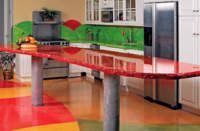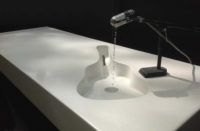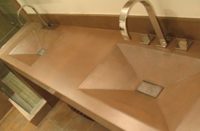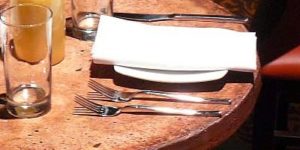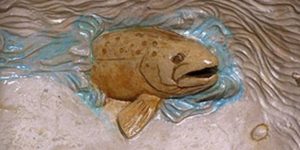
As decorative options for concrete in countertops and other home elements evolve, mix designs are becoming more sophisticated and specialized. While many fabricators develop their own proprietary formulations, there are also companies that market specialty bag mixes designed to give contractors everything they need to create countertops or other home elements.
Mike Heidebrink, president of concrete countertop pioneer Cheng Concrete, sees this trend as validation of the concrete countertop industry. “There’s a whole world of new products out there and it’s a good sign that our industry has carved out its niche in the marketplace,” he says. “It testifies to our longevity that there are now specific products being developed for countertops.”
 In the bag
In the bag
Bag mixes for countertops share some characteristics: They are designed to minimize cracking and shrinking, they are strong enough to be poured in thinner slabs and they are optimized for workability. Most have a compressive strength of 6,000 psi or higher, typically earning the designation of “high performance” from the American Concrete Institute. However, suppliers generally agree that it is not compressive strength alone that is important to countertops. Rather, the same properties that give a mix high psi also make it denser and allow for thinner slabs. High-performance concrete also replicates fine mold details better. Finally, high psi may contribute to preventing damage during shipping and installation.
SureCrete Design Products offers two bag mixes in its Xtreme series for home elements. One is Xtreme Countertop, a two-part fast-curing cementitious composite that can be poured as thin as 1/2 inch, demolded in four hours and polished after eight hours. “This material can be precast and installed the next day,” says Damon Hoover, sales manager for SureCrete’s CarpenterStone division.
Xtreme Countertop has a compressive strength of more than 10,000 psi. It is formulated with an admixture that allows several pounds of fiber to be added and dispersed evenly, which adds tensile strength to reduce cracking and allow for large spans.
 Another SureCrete product, Xtreme Lightweight, is popular for home elements that do not require the same wear surface as countertops. This cementitious composite material is supplied in three components. The vermiculite and cement mix aggregate makes the material 65 percent lighter than traditional concrete. At 2,200 psi, this product is best suited for vertical, nonweight-bearing applications like wall treatments, faux balcony balustrades, exterior cladding and crown molding. At just 44 pounds per cubic foot, Hoover says, “This is a huge advantage for architects and engineers designing for weight. It can save money because designs don’t require extra structural support.” It can also be cut with traditional woodworking tools.
Another SureCrete product, Xtreme Lightweight, is popular for home elements that do not require the same wear surface as countertops. This cementitious composite material is supplied in three components. The vermiculite and cement mix aggregate makes the material 65 percent lighter than traditional concrete. At 2,200 psi, this product is best suited for vertical, nonweight-bearing applications like wall treatments, faux balcony balustrades, exterior cladding and crown molding. At just 44 pounds per cubic foot, Hoover says, “This is a huge advantage for architects and engineers designing for weight. It can save money because designs don’t require extra structural support.” It can also be cut with traditional woodworking tools.
Xtreme Lightweight can be sprayed, hand-packed or poured into molds. Hoover knows one artist who etches designs onto glass and molds the product against the etched glass to pick up the details of the design. “The material reads the characteristics of whatever mold you pour it into,” he says. As for color options, Xtreme Countertop and Lightweight are both cement-based, Hoover says, so any coloring system works the same as it would with regular concrete.
 Another high-performance mix for countertops is available as part of the enCounter professional concrete countertop system, sold to contractors through The Stamp Store, based in Oklahoma City. Doug Bannister developed this mix to address the issues that challenged him most in using concrete for countertops. “I wanted a material that would do everything like concrete except crack. I wanted it to trowel, color, stain, finish and feel like concrete without the cracking that everybody says is inevitable.”
Another high-performance mix for countertops is available as part of the enCounter professional concrete countertop system, sold to contractors through The Stamp Store, based in Oklahoma City. Doug Bannister developed this mix to address the issues that challenged him most in using concrete for countertops. “I wanted a material that would do everything like concrete except crack. I wanted it to trowel, color, stain, finish and feel like concrete without the cracking that everybody says is inevitable.”
Bannister first attempted to adapt ready-mix concrete for countertops by adding superplasticizers and fibers. “What I learned was that these interfere with performance,” he says. “Plasticizers can be sticky, which compromises the finish. Fibers come springing to the surface if you’re staining because you’re eroding the paste. They make it hard to seal.”
Bannister’s approach was to precisely blend ingredients in the right ratios to create the characteristics he wanted without additives or fibers. “It is (partly) a matter of reducing water,” he says. “The more water it requires, the more it will shrink and curl.” The result is an 8,870-psi material that he claims will not shrink or crack. To demonstrate, he keeps a span of concrete in his showroom that is more than 18 feet long with no support. “It’s been two years and it hasn’t sagged yet,” he says.
The comprehensive enCounter system includes not only the complete mix, but also reusable edge forms and premeasured colors.
LifeTime Floors LLC offers three countertop mixes in its Quicktops line. The original product, Quicktops Premium, is a “bag and bucket,” according to project manager Kenton Hove. The kit includes 50 pounds of dry material and a 2.5 gallon bucket of liquid with acrylic to add strength and fibers to improve tensile strength and eliminate surface cracking.
Two new additions to the line eliminate the bucket — all ingredients are supplied dry and the contractor adds only water and color. Quicktops-One incorporates white marble aggregates that are exposed when polished. Quicktops e mix is the company’s most economical offering at about $38 per 50-pound bag. “When this material is cast without being colored, the look resembles Indiana limestone,” Hove says. “This makes it popular for fireplace hearths and surrounds. I’ve even seen it used for water features, capstones and furniture pieces.”
All three reach about 3,500 psi in four hours. At that point the products can be demolded and polished. All three can be colored with any iron oxide or liquid color dispersion.
Hove believes these bag mixes offer several advantages. One is consistency. “All components are weighed and measured out so they are identical, bag to bag,” he says. Another is convenience. “Contractors don’t have to add admixtures or fibers. They don’t have to spend time shopping for ingredients. We take the leg work out.”
The fact that the formulation is designed for fast cure also makes precast operations faster and more controllable. “These are tested, proven products designed specifically for the four-hour time frame,” Hove says. “You can do countertops in just one or two days. Contractors really increase productivity with a bag mix.”
New uses for a high-end mix
Another product making some inroads into the home element arena is Ductal from Lafarge North America. Ductal is a cementitious composite material with ultra-high strength — up to 30,000 psi. The material was developed to deliver structural performance without metal reinforcement. Not a traditional concrete, Ductal has no coarse aggregate. Plasticizer and reinforcing fibers (PVA or metallic) are included. “We’ve done a lot of work on the geometry of the fibers as well as their physical properties and interaction with the matrix,” explains Vic Perry, vice president and general manager for Ductal. “To get the same tensile strength in all directions the fibers must be dispersed in an isotropic manner. We’ve studied all the materials in the matrix, the aspect ratios, and how they work together.”
Ductal offers tremendous benefits in structural applications, where it eliminates the cost and weight of traditional steel and concrete. Because it can be molded into complex shapes in very thin sections, it is being used in some residential and decorative applications as well. “As long as you can build a mold to the shape you want, you can cast Ductal into that mold,” Perry explains. “Because the matrix is made of fine materials, it replicates the texture of the mold very precisely.”
One group using Ductal this way is Solus Décor Inc., of Vancouver, British Columbia. They use Ductal to create very durable outdoor features like planters and benches. “A standard concrete pot is thick, chunky, rough-textured and weighs a ton,” explains Solus partner Brad Carpenter. “With Ductal the mold can be a lot more elegant and we can cast a much thinner profile. This material is very strong, very robust. It’s going to outlast you and me.”
Carpenter does caution that Ductal is very different from concrete to work with. He describes the viscosity as “almost an oatmeal” and says the quick set reduces working time. The material cost, seven to eight times the cost of regular concrete, means errors are expensive, a challenge compounded by the fact that there is less margin for error with thin molds. The same applies to adding color — pigments react differently with Ductal and the cost of experimenting is high. “We limit our offerings to colors we know will sell better,” Carpenter says.
Ductal does not so much compete with concrete as it allows applications that are not possible with concrete. “Our customers buy Ductal because it enables them to do things that are unique,” Perry says. “My advice is, use concrete to do what concrete does, and use Ductal to do things you can’t ordinarily do.”
Bag or scratch?
Proponents of bag mixes cite ease of use, consistent ingredients and reproducible results as key advantages. But some suppliers and artisans prefer designs for scratch mixes. For example, the Concrete Countertop Plant, part of Pinnacle Cast Concrete, sells all the equipment contractors need to set up shop for making countertops. Then they design the mix based on materials available locally to each contractor. Pinnacle general manager Mark Celebuski explains. “We base mixes on materials (sand, stone and cement) that customers can get locally. They tell me what’s available where they are and I them what to add. They generally need fiber, admixtures and high-quality pozzolan to achieve high performance.” Pinnacle sets a standard for the concrete and works with the contractor using local materials until that standard is met. “I just don’t believe we should be shipping countertops or raw materials across the country,” Celebuski says. “We want customers to get everything they need within 50 miles. Plus, contractors can save about $5 per square foot by mixing their own concrete.”
The Ashby System from Concrete Solutions is a proprietary admixture supplied in a two-gallon bucket with a packet of fibers to be mixed into three bags of any concrete a contractor cares to use. The system hinges on maximizing the performance of the ingredients and minimizing water. “If you can use 100 percent of the available cement, you have a denser mix, greater psi and tensile strength and better scratch resistance,” says concrete artisan Ben Ashby.
Fine polypropylene fibers are part of the Ashby system. “Most people think the fiber is there for reinforcing, but it actually gives very little reinforcement because it does not bond well with cement,” he says. “Instead, the mesh keeps water from migrating and forming capillaries which can weaken the concrete. Also, because the mix is so dry, it must be vibrated hard. The mesh prevents the aggregates from segregating during this process.”
Jeffrey Girard, P.E., president of the Concrete Countertop Institute in Raleigh, N.C., has evaluated various bag mixes and appreciates their role in the marketplace. He does not believe, however, that a good bag mix compensates for lack of knowledge. “There is a misconception that all you need to know is in the bag,” he says. “That’s like saying all you need to know about baking is in the box. A bag mix may be simplified, but you still have to understand concrete — how it cures, the right water/cement ratio, how to reinforce it.”
Pinnacle’s Celebuski agrees. “Countertops are not just flashy design. Contractors need to take the responsibility for becoming experts in concrete.”
